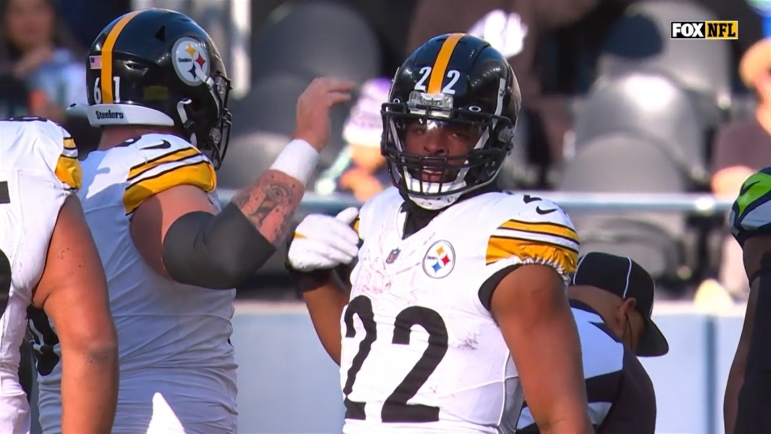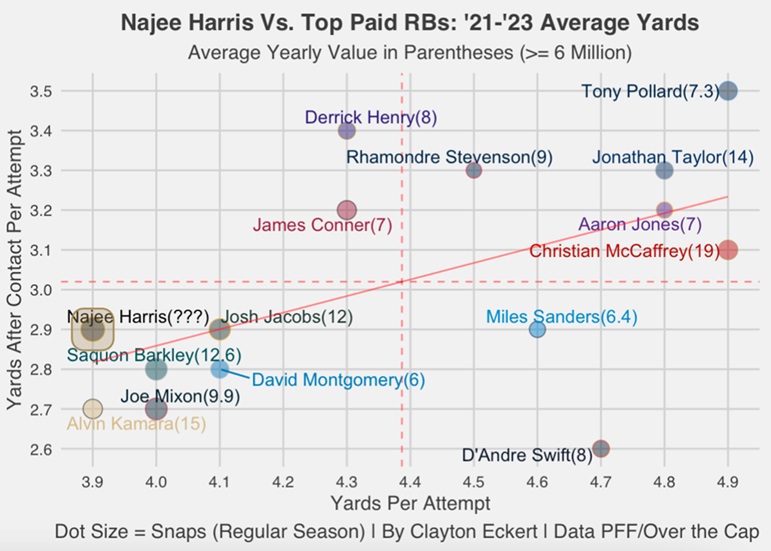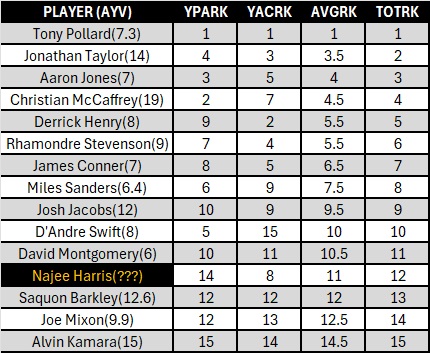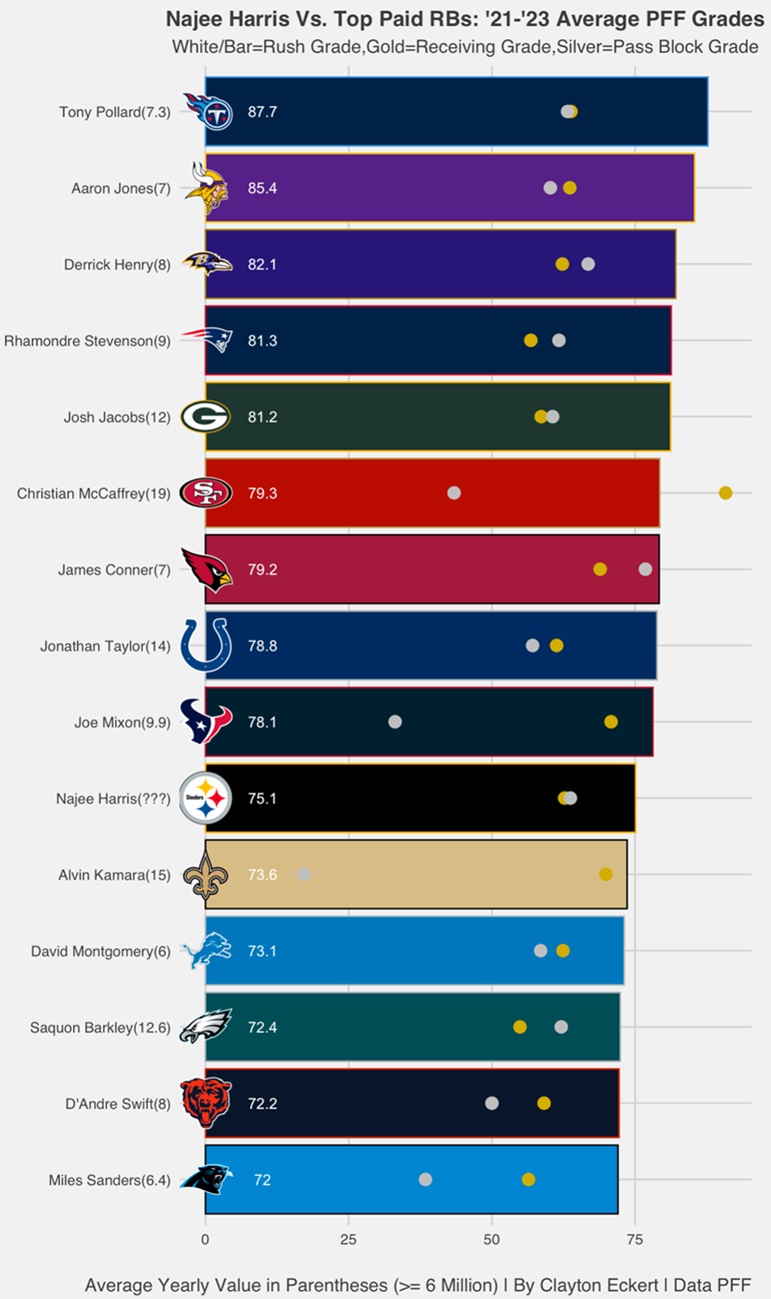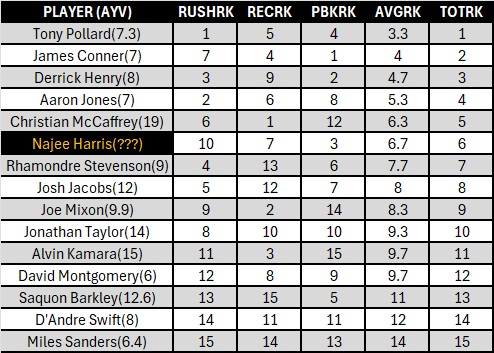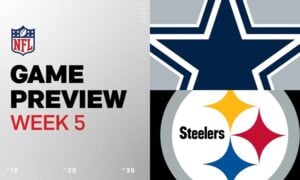A candidate for a summer contract extension with the Pittsburgh Steelers is running back Najee Harris. My goal today is to use a statistical approach to see how Harris has performed the last three seasons compared to the top paid players at the position currently via Over The Cap.
First, I wanted to see where Harris stacked up among RBs at an average yearly value of six million or more in yards per attempt and yards after contact per attempt on rushes. Many factors can go into yards per attempt, notably offensive line play, while yards after contact is more reflective of factors more in the RBs control.
I averaged those numbers the last three seasons from Pro Football Focus (PFF), along with total snaps over the span as their dot sizes. Here are the results:
Most encouraging for Harris is total snaps, illustrated by the dot sizes. He had 2,309 total snaps, which is the most of the 15 qualifying RBs over the timeframe. That is extremely valuable at any position especially with the wear and tear RBs endure along with an underappreciated element of a devalued position group across the NFL.
Looking at the average yearly values in totality, we see just five RBs above ten million: Christian McCaffrey (19), Alvin Kamara (15), Jonathan Taylor (14), Saquon Barkley (12.6), and Josh Jacobs (12). Only two of them landed on the top right – McCaffrey and Taylor.
Three of those five players have changed teams the last three years along with ten of the 15 focused players. That again emphasizes how teams have been willing to move on from quality RBs and the fungible market overall, despite the importance of the position.
Circling back to Harris, we see he was below-average in both yardage data points. The large quantity of plays compared to his peers is important to factor in but also gives a gauge to the quality comparatively. His 3.9 yards per attempt tied for the lowest among qualifiers while a 2.9 yards after contact number tied for eighth with Josh Jacobs and Miles Sanders.
As I stated in the opening, yards after contact is the more important number for RBs and Harris faring better in that regard is helpful to his cause. That is particularly true considering some of the subpar offensive line units Pittsburgh has trotted out the last three seasons.
On the other side of the coin, it was still below the mean of his peers. Several notable players were above-average, including some at the top of the market (McCaffrey, Taylor), newly signed Patriots RB Rhamondre Stevenson, and former Steeler in James Conner.
Our own cap guru Dave Bryan compared Stevenson’s new deal to his proposed Harris extension that you should definitely check out. In that post, Bryan proposed a $9.9 million new money average that would eclipse Stevenson ($9.0 million). The latter fared much better in the yardage visual above, but that came on the least snaps of the timeframe, 1,445, compared to Harris as the top dog at 2,309.
Now we have some starting context to the contracts at the position currently, and where Harris’s second contract could potentially slot in thus far.
Going deeper, here is a ranking table of the stats from the first visual, including yards per attempt (YPARK), yards after contact per attempt (YACRK), averaging the two (AVGRK), then using total snaps as a tiebreaker to get a final ranking (TOTRK) of the 15 qualifying players along with their average yearly values (AYV) in parenthesis:
Harris lands 12th out of the 15 qualifiers, which isn’t the rosiest of pictures when considering the likelihood of a possible contract extension. Pittsburgh also declined to pick up his fifth-year option recently, roughly a 6.7 million contract compared to his current 3.3 average yearly value on his current rookie deal.
Considering all the factors, he may be the least likely of the extension candidates, with defensive linemen Cameron Heyward and tight end Pat Freiermuth being more probable.
Next, I wanted to look at multiple facets of the game over the three-year span, another underappreciated element to RB play. The visual below are PFF grades in rushing, receiving, and pass blocking:
Lots of info to unpack here. First, the bars indicate and sort the best-to-worst rushing grades over the sample size, where Harris posted a 75.1, which ranked tenth. Considering PFF grading is on a play-by-play basis and factors many things into the equation, it is notable that he moved up the ranks compared to the initial view.
The dots represent the other grades with the gold dot showing receiving grades and silver their pass block grades. Harris had a 62.7 receiving grade and 63.7 pass block grade over the span, which doesn’t sound impressive, but ranked seventh and third, respectively. So, Harris has provided more than just rushing as a well rounded back, despite losing opportunities to fellow Pittsburgh RB Jaylen Warren’s emergence the last two seasons.
The latter is another reason many are against a possible Harris extension. I am in the camp that the two complement each other very well and would be worth keeping together at the right price moving forward to see if the running game can find more consistency with the investments in the offensive line and that side of the ball this offseason.
Now, here is a similar ranking table as earlier, including rushing grade (RUSHRK), receiver grade (RECRK), pass block grade (PBKRK), averaging the three (AVRRK), then using the same tiebreaker of total snaps to get the final rank (TOTRK):
This view paints Harris in a much more favorable light, ranking sixth in total rank among his 15 qualifying peers. Yes, Harris has played less on passing downs where he fared best, namely on third downs with Warren eating up more of those opportunities with quality play. But, that is no slight on Harris, who has contributed as well in the passing game.
The main culprit to that is Warren having more explosive play ability, though Harris has made strides in that regard after struggling with explosive plays in college and his first two years in the league.
It is rare to find a back that can do it all at an average level or better, and I am of the belief that Harris falls into that camp. Guys like Tony Pollard, Conner, Derrick Henry, Aaron Jones, Taylor, and Harris ranked in the top ten in each grade, ranging from seven to 14 million in average yearly value.
Harris would likely balk at the lower end of that price range but shouldn’t expect to land at the top of it, either. He slots on the final table just above Stevenson, which seems appropriate given Bryan’s opinions that I laid out earlier.
It is interesting that there is a notable gap from players below ten million, to the next highest player in Jacobs at 12 million, which certainly impacts a potential Harris deal.
If Pittsburgh chooses to offer Harris a contract extension, an average yearly value in the nine million range as Bryan outlined seems appropriate from a strictly analytic perspective as well.

